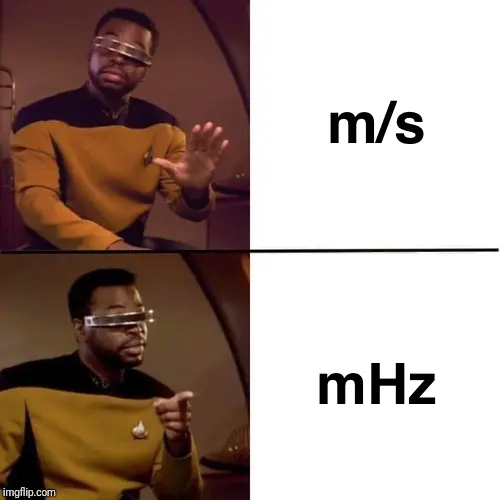This is actually pretty important to being able to solve engineering problems in the real world. Invariably, every little sub industry has its own cursed unit system. And dimensional analysis is great for solving real problems on its own.
And if you get to a high enough physics level, they start setting hbar = c = 1 or G = c = 1, and you never have to worry about it again.
I’m the mean time, it’s worthwhile to learn the trick to do this stuff fast-ish.
I dislike that my highschool never once gave me the concept that units can simply be treated like constants to be cancelled out.
I used to do the conversions for each variable before putting them in the equation like a fool.
Now I’m slapping all of the conversions alongside the original values/units in a single expression like god intended.
I would like to introduce everyone to this video about cursed unit (youtube link warning)
kWh has an intuitive reason. Watts are so small that you’d always calculate consumption in MJ and whatnot, and seconds are so short that you’d always be expressing time in ks. Using kWh will reduce the numbers to useful ranges and makes cancelling M and k unnecessary.
Yeah, he elaborated it in his second video about the cursed unit that cursed ≠ useless.
In a parallel universe, someone is memeing about how teachers waste our time on useless stuff and never taught us to convert between units.
I’ll be pissed if the comments are about metric units

That’s interesting. Obviously, you’d put a center dot to disambiguate millihertz from meter-hertz, but I can’t recall ever having learned a rule about that. So some combinations of units are inherently ambiguous?
Also: Hz/dpt.
I can’t tell which unit is more cursed: millihertz or meter hertz. Surely, anything that could be measured in millihertz is more natural to measure as a period, or as revolutions per minute or something, right?
EDIT: Also, TIL about dpt. Thanks!
A dioptre (British spelling) or diopter (American spelling), symbol dpt, is a unit of measurement with dimension of reciprocal length, equivalent to one reciprocal metre, 1 dpt = 1 m^−1.
TIL about dpt
Tell me you don’t [Edit: need] glasses without telling me you don’t need glasses :D
I actually do have glasses, I just never bothered learning about any of the technical details behind my lenses. Optometrist measured my eyes, I chose the cheapest frame the store offered, came back a week later to pick up the glasses and that’s about it.
Just divide by 3.6
Example:
10 km /h * 1000 m / km = 10,000 m /h
10,000 m/h * 1h/3600s = 10,000/ 3,6000 m/s = 10/3.6 m/s
I used to do it this way in highschool, but could never remember if it was divide by or multiply by 3.6
Instead I now do it as you have shown, except it all goes in the same expression.
10 km/h * 1000 m/km * 1h/3600s = 2.778 m/s
No need for the extra steps. Slap it all in the same expression and put it in the calculator (being careful to check that the units cancel as intended)
M/s is faster (lower number) than km/h so… That should give you enough explanation to understand whether you need to divide or multiply 3.6 when converting.
It just never stuck. Just for me personally it’s easier to remember the base conversions of 1 km = 1000 m and 1 hr = 3600 and do the maths.
Just my own personal preference, and when dealing with more complex units, is the only way.




